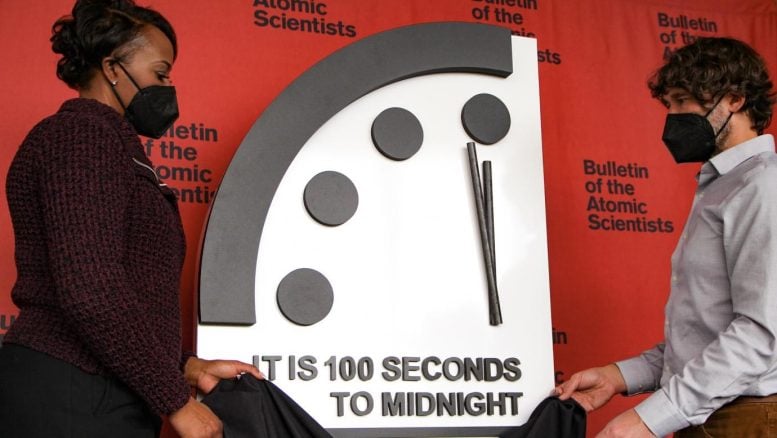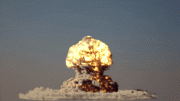
Members of the Bulletin of Atomic Scientists, Suzet McKinney (Director of Life Sciences for Sterling Bay) and Daniel Holz (University of Chicago professor), reveal that the Doomsday Clock remains at 100 seconds to midnight in 2022. Credit: Courtesy of the Bulletin of the Atomic Scientists
Bulletin of the Atomic Scientists warn of lack of progress on climate, nuclear weapons.
The Bulletin of the Atomic Scientists announced on January 20 that the hands of the Doomsday Clock remain at 100 seconds to midnight—the closest it has ever been to apocalypse.
The Bulletin meets every year to determine how much metaphorical time we have to avert catastrophe for humankind. Over the past 75 years, the hands of the clock have moved both backward and forward according to whether steps were taken to address potentially civilization-ending threats, such as climate change and nuclear war.
In 2020, the Bulletin set the hands of the clock at 100 seconds to midnight, moving them forward from two minutes. For the second year in a row, the organization determined that not enough progress has been made to move the hands back.
According to the Bulletin’s statement, the decision does not suggest that the situation has stabilized: “On the contrary, the Clock remains the closest it has ever been to civilization-ending apocalypse because the world remains stuck in an extremely dangerous moment.”
“The Doomsday Clock is holding steady, but steady is not good news,” said Sharon Squassoni, professor at George Washington University and co-chair of the Bulletin board that sets the clock. “We are stuck in a perilous moment—one that brings neither stability nor security. Positive developments in 2021 failed to counteract negative, long-term trends.”
In their decision, the Bulletin cited disinformation, global security threats including ‘nuclear saber rattling,’ lack of actionable climate policies, disruptive technology and insufficient worldwide COVID-19 response.
“There is no more time to waste.”
— Raymond Pierrehumbert, board member and University of Oxford Professor
The Bulletin of the Atomic Scientists was created 77 years ago by a group of concerned Manhattan Project scientists, many based at the University of Chicago, shortly after the atomic bombings of Hiroshima and Nagasaki. Two years later, in 1947, artist and Bulletin member Martyl Langsdorf created the iconic Doomsday Clock to signal how close humanity was to self-destruction.
Today, the Doomsday Clock is located at the Bulletin offices in the Keller Center, home to the University of Chicago Harris School of Public Policy.
Though it was first created in response to nuclear weapons, the clock reckoning now includes climate change and “disruptive technologies,” such as bio- and cybersecurity.
However, the Bulletin has always emphasized that the clock is not intended to make people fearful, but rather to spur them to action. The full statement lists a number of actions needed to make the world safer, and urges people to press their governments for action.
“There is no more time to waste,” said board member and University of Oxford Prof. Raymond Pierrehumbert.








what is this man?
“Cognitive psychologist Steven Pinker harshly criticized the Doomsday Clock as a political stunt, pointing to the words of its founder that its purpose was ‘to preserve civilization by scaring men into rationality.’ He stated that it is inconsistent and not based on any objective indicators of security, using as an example its being farther from midnight in 1962 during the Cuban Missile Crisis than in the ‘far calmer 2007’. He argued it was another example of humanity’s tendency toward historical pessimism, and compared it to other predictions of self-destruction that went unfulfilled.” — Wikipedia
Did we learn anything from WWII. Camberlain continued to give in to a madman, feels like the same to me. What I stutter to think is now the stakes have changed, we can destroy the entire world in less than a hour ( quicker than the 50 year path we are on now) but I digress. Once the powder keg is lit we don’t know where this will go.
Steven Pinker is not a nuclear scientist. He is also not a very good scientist at all… He’s a pop psychologist who has figured out how to make a name for himself with shoddy analytics. To borrow a phrase from Clyde Spencer’s post, Steven Pinker is himself engaged in a rather extensive political stunt–using cherrypicked data to justify his particular political positions. https://www.opendemocracy.net/en/transformation/steven-pinker-s-ideas-are-fatally-flawed-these-eight-graphs-show-why/
if there is one thing that people who study history can tell you, it’s that history is doomed to repeat itself. Eventually just like with the dinos there will be an extinction level event. It’s not a matter of if but, when. The path that mankind is on now is not good things need to change we need to stop polluting our oceans, we have to protect the bees like them or hate them, if global warming exists we need to slow it down, and we need to avoid nuclear war at all costs.
JJ,
I wasn’t fully convinced either way about the validity (or not) of Steven Pinker’s criticisms, but you’ve really clarified the issue for me. If you’d engaged with (or even mentioned) the arguments Pinker made against the Clock, you might have convinced me there was something wrong with them. But you didn’t, did you? All you did was denigrate Pinker himself and link us to a long and (as far as I can tell) irrelevant post about other stuff he’s written over the years. I hope you weren’t attempting to bolster the Clock’s credibility, because you achieved the exact opposite. Next time I see a Pinker book at the store I’ll be strongly inclined to buy it.